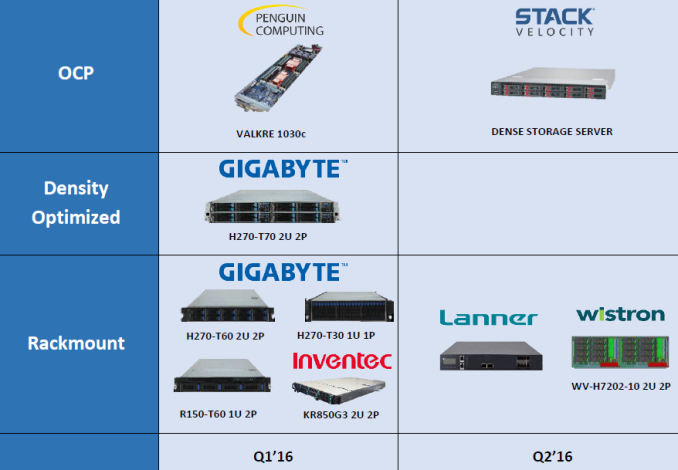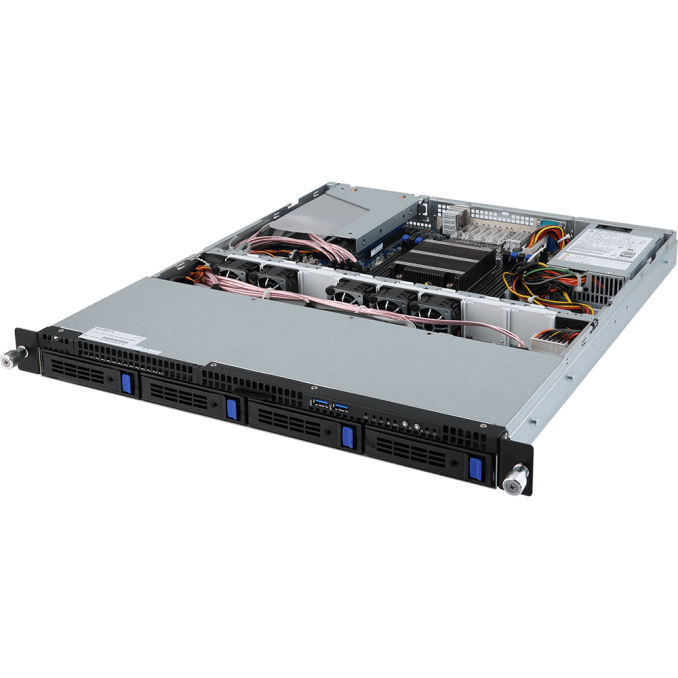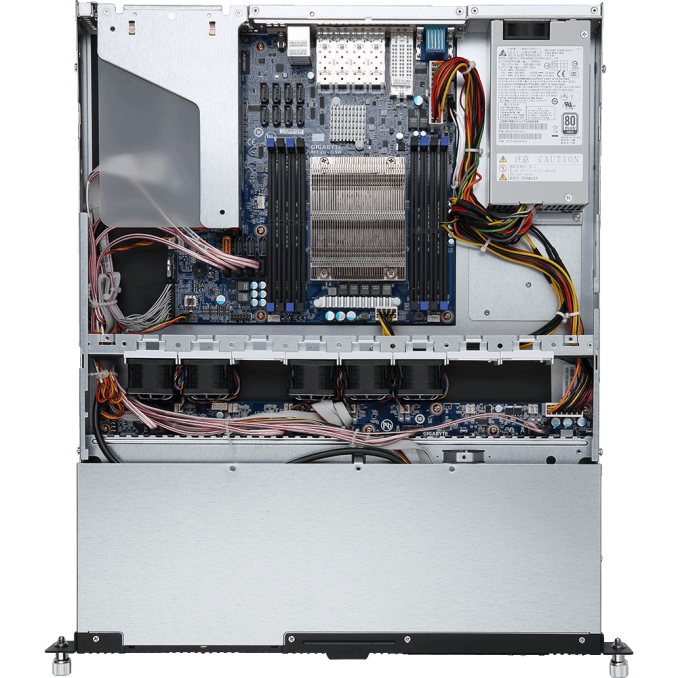Investigating Cavium's ThunderX: The First ARM Server SoC With Ambition
by Johan De Gelas on June 15, 2016 8:00 AM EST- Posted in
- SoCs
- IT Computing
- Enterprise
- Enterprise CPUs
- Microserver
- Cavium
Xeon D vs ThunderX: Supermicro vs Gigabyte
While SoC is literally stands for a system on a chip, in practice it's still just one component of a whole server. A new SoC cannot make it to the market alone; it needs the backing of server vendors to provide the rest of the hardware to go around it and to make it a complete system.
To that end, Gigabyte has adopted Cavium's ThunderX in quite a few different servers. Meanwhile on the Intel side, Supermicro is the company with the widest range of Xeon D products. 
There are other server vendors like Pengiun computing and Wistrom that will make use of the ThunderX, and you'll find Xeon D system from over a dozen vendors. But is clear that Gigabyte and Supermicro are the vendors that make the ThunderX and Xeon D available to the widest range of companies respectively.
For today's review we got access to the Gigabyte R120-T30.
Although density is important, we can not say that we are a fan of 1U servers. The small fans in those systems tend to waste a lot of energy.
Eight DIMMs allow the ThunderX SoC to offer up to 512 GB, but realistically 256 GB is probably the maximum practical capacity (8 x 32 GB) in 2016. Still, that is twice as much as the Xeon D, which can be an advantage in caching or big data servers. Of course, Cavium is the intelligent network company, and that is where this server really distinguishes itself. One Quad Small Form-factor Pluggable Plus (QFSP+) link can deliver 40 GB/s, and combined with four 10 Gb/s Small Form-factor Pluggable Plus (SFP+) links, a complete ThunderX system is good for a total of 80 Gbit per second of network bandwidth.
Along with building in an extensive amount of dedicated network I/O, Cavium has also outfit the ThunderX with a large number of SATA host ports, 16 in total. This allows you to use the 3 PCIe 3.0 x8 links for purposes other than storage or network I/O.
That said, the 1U chassis used by the R120-T30 is somewhat at odds with the capabilities of ThunderX here: there are 16 SATA ports, but only 4 hotswap bays are available. Big Data platforms make use of HDFS, and with a typical replication of 3 (each block is copied 3 times) and performance that scales well with the number of disks (and not latency), many people are searching for a system with lots of disk bays.
Finally, we're happy to report that there is no lack of monitoring and remote management capabilities. A Serial port is available for low level debugging and an AST2400 with an out of band gigabit Ethernet port allows you to manage the server from a distance.













82 Comments
View All Comments
Spunjji - Wednesday, June 15, 2016 - link
Well, this is certainly promising. Absent AMD, Intel need some healthy competition in this market - even if it is in something of a niche area.niva - Wednesday, June 15, 2016 - link
This is the area where profits are made, not "something of a niche area."Shadow7037932 - Wednesday, June 15, 2016 - link
Yeah, I mean getting some big customers like Facebook or Google would be rather profitable I'd imagine.JohanAnandtech - Thursday, June 16, 2016 - link
More than 30% of Intel's revenue, and the most profitable area for years, and for years to come...prisonerX - Wednesday, June 15, 2016 - link
This is the future. Single thread performance has reached a dead end and parallelism is the only way forward. Intel's legacy architecture is a millstone around its neck. ARM's open model and efficient implementation will deliver more cores and more performance as software adapts.The monopolists monopolise themselves into irrelevance yet again.
CajunArson - Wednesday, June 15, 2016 - link
" Intel's legacy architecture is a millstone around its neck."I wouldn't call those Xeon-D parts putting up excellent performance at lower prices and vastly lower power consumption levels to be any kind of "millstone".
"ARM's open model and efficient implementation "
What's "open" about these Cavium chips exactly? They can only run a few specialized Linux flavors that don't even have the full range of standard PC software available to them.
What is efficient about a brand-new ARM chip from 2016 losing at performance per watt to the 4.5 year old Sandy Bridge parts that you were insulting?
As for monopolies, ARM has monopolized the mobile market and brought us "open" ecosystems like the iPhone walled-garden and Android devices that literally never receive security updates. I'd take a plain x86 PC that I can slap Linux on any day of the week over the true monopoly that ARM has over locked-down smartphones.
shelbystripes - Wednesday, June 15, 2016 - link
You're right to criticize the "millstone" comment, Intel has done quite well achieving both high performance and high performance-per-watt in their server designs.But your comment about a "true monopoly" in the "locked-down smartphone" market is ridiculous. The openness (or lack thereof) that you're complaining about has nothing to do with the CPU architecture at all. An x86 smartphone or tablet can just as easily be locked down, and they are. I own a Dell Venue 8 7000, which is an Android tablet with an Intel Atom SoC inside. It's a great tablet with great hardware. But it's got a bunch of uninstallable crapware installed, Dell abandoned it after 5.1 (it's ridiculous that a tablet with a quad-core 2GHz SoC and 2GB RAM will never see Marshmallow), and the locked smartphone-esque bootloader means I can't repurpose it to a Linux distro even if one existed that supported all the hardware inside this thing.
On the flipside, the most popular open-source learning/development solution out there right now is the ARM-based Raspberry Pi. There are a number of Linux distros available for it, and everything is OSS, even the GPU driver.
TheLightbringer - Thursday, June 16, 2016 - link
You haven't done your homework.Some mobile devices were coming with Intel. But like Microsoft it entered the market too late, without offering any real value. The phrase "Too little, too late" fit them both.
ARM didn't do a monopoly. They just simply saw an opportunity and embrace it. In the early IBM clone days Intel licensed their architecture to allow competition and broad arrange of products. After the market was won, they went greedy, didn't licensed the architecture anymore and cut a lot of players out, leaving a need for a chip licensing scheme. And that's where ARM got in.
Google develops Android OS, but is up to phone vendors and carriers to deploy them. And they don't want to for economic reasons. They prefer to sell you a new phone for $$$.
Intel and MS got in the mobile/car market exactly what they deserve, nothing else.
junky77 - Friday, June 17, 2016 - link
they all greedy. Some just play it smartly or have more luck in decision makingBut, yea, when you read about the way IBM behaved when things were fresh - it's quite amazing. They had much of the market and could do a lot of stuff, but they simply had a very narrow mind set
soaringrocks - Wednesday, June 15, 2016 - link
You make it sound like it's mostly a SW problem, I think it's more complex than that. Actual performance is very dependent on the types of workload and some tasks fit Intel CPUs nicely and the performance per watt for ARM is lacking despite the hype of that architecture being uniquely qualified for low-power. It will be fun to watch how the battle evolves though.